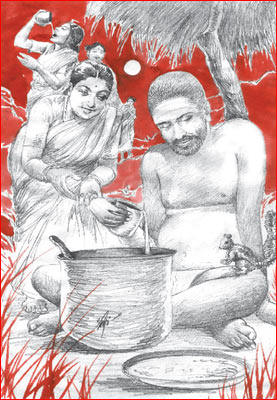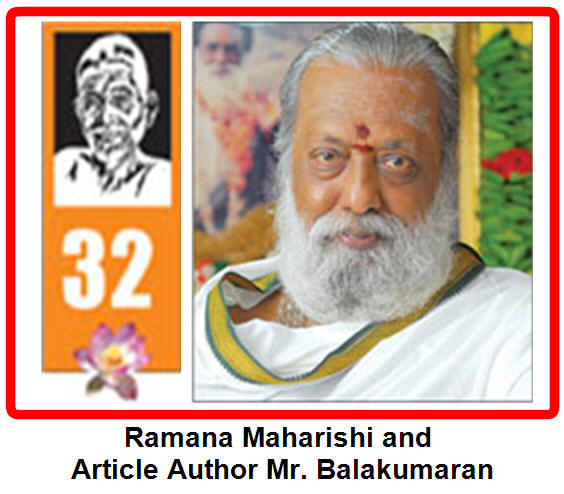Sakthi Vikatan-
28 Jun, 2011
SriRamana Maharishi
Self-realized Jñānis subscribe to the welfare of all people. They do not
entertain liking just for the rich and their favorite people. They like
all equally.
The working women collect firewood near the mango tree cave and as they
go down the hill, they put down the load and offer homage to Bhagavan
with opposed palms. They prostrate on the ground before Bhagavan. Their
skin is itchy, dark and thick from injury from thorns, wind, sun and
sweat.
They request Ramanamaharishi to sprinkle some water on their backs. Then
they drink water, take rest and move on.

Bhagavan used to serve the cooked Kañji
(gruel) made of grains obtained by begging by the devotees. He used to
ladle the gruel into their cups. They used to call it Ambrosia that
satisfied their hunger.
It rains for everybody; likewise, Periyava’s compassion rains on all
equally, regardless of their personalities, their stations in life, and
(caste) poverty or privilege.
He talked high principles and was in the forefront to help the
underprivileged, and treated all equally. Bhagavan’s younger paternal
uncle Nellaiyappar came to Virūpākṣi cave and had Darśan of him.
Bhagavan did not speak to him at all. He stayed for one day and left for
home. A youth visiting the cave often asked Periyava to explicate the
Dhakshinamurthy Slokas. It is usual for Bhagavan to sit facing the
entrance to the cave. But that day, he sat the youth opposite to him
with his (Bhagavan’s) back to cave entrance.
That time, Nellaiyappar came for another Darśan.
Nellaiyappar stood behind Bhagavan and wondered about his nephew (older
brother’s son) who was late in talking as a child, did not speak to him
at this visit and now was explicating Vedanta to a disciple. Bhagavan
was explaining the fourth Slokam. Nellaiyappar understood that his
brother’s son became the exponent of Tattvas. There was a time when
Nellaiyappar worried about the future of his elder brother’s son but
when he heard the explanation, he understood that Bhagavan (his nephew)
was a powerhouse shining like a Tattva-flame (Exponent of Tattvas).
The explanation given by Bhagavan to Ādisankarā’s Dhakshinamurthy
Stotras was wonderful. He wrote a forward to Dhakshinamurthy Stotras.
What is this saying? The four mind-born sons of Brahma were told by
their father they were created for worldly purpose (to create progeny
and multiply).
They lost faith (in that paradigm) and were disenchanted. They
were in search of Truth, wanting to have peace of mind. Paramesvara
Himself for the benefit of these foursome seeking him sat under the
Banyan Tree in Cin Mudra pose. When they saw him, they went near him as
iron is drawn towards the magnet and sat before him.
Nellaiyappar came in when Periyava was explicating the 4th
Verse.
Verse 4. I pay homage to Guru Dhakshinamurthy, the refuge of Tapasvins,
whose light shines in the false-appearing organs; who brings the
knowledge of ‘Thou Art That;’ and who when seen directly ensures no
casting in the ocean of metempsychosis.
--Periyava
He whose light gleams through the senses like the light emanating from a
pot with holes (in which a lamp is kept), He whose knowledge alone
brings the state of knowing (I am That), He whose brightness makes
everything shine - to that Dakshinamurti, who is embodied in the
auspicious Guru, I offer my profound salutations. Shivam.org
Once he heard the explication, the thought that Maharishi was the son of
his elder brother, left him. Nellaiyappar realized a Tattva form is
seated here. Here there are
no long-winded instructions. There are no Q&A sessions. Seeing the
Truth-Form of Ramana Maharishi, the mind of the Tapasvins involutes.
Body, breath, organs, Buddhi…involute into nothingness.
We see multiplicity in ‘I,’ you, he, women, men, the challenged, the
sight-impaired… But, who are they?
If we understand that the body, breath, organs, Buddhi… involute in the
Great Path. We should
understand, ‘This’ exits in all objects. That being so, where is (and
why is there a)
division? Our homage to
Dhakshinamurthy who makes us realize these principles.
SriRamana Maharishi wrote the explication of Dhakshinamurthy Slokam and
Sriguru Sthuthi.
Ādisankara on his India tour, won the debate with Mandal Pundit living
in Māyimathi
in North India, proficient in Karma Kāṇḍam.
His wife, the moderator, said that Sankara must win the debate with
her to claim his complete victory. She was of the form of Sarasvati.
If Sankara declared that he knew Kāma
Sastra, his Sannyāsam
will be declared suspect and false. If he declared that he was not familiar with Kāma
Sastra, the debate-seeking experienced woman would declare victory.
Sankara asked for a month of grace period before his intended debate.
He left his body in a mountain
cave and asked his disciples to watch over his body. He entered the body
of a dead king, had intimacy with his wives and became conversant with Kāma
Sastra. Since Sankaracharya did not show up to the disciples, the
disciples in the pose of itinerant singers went to the palace and sang
Gurusthuthi before Sankara.
This is the first poem in Gurusthuthi translated by Bhagavan. In the
elucidation of gross and subtle forms of Braḥmam, there were many ‘Neti,
Neti,’ (Not this, not this) exclusions. The Self form of the Lord
(Braḥmam) is what remains after a multitude of serial exclusions.
Braḥmam is also beyond the beyond.
Brahmam is the One retained in the hearts of the Jñānis, whose
greatness is beyond words.
The most ancient Supreme Lord is Sat-Cit-Āṉanda
and Braḥmam.
‘Is this God? No; Is the idol the God? No; Is God a mere observance of
injunctions? Are the temples God? No; Is Ciṉṉamma
God? No; Is Kaṭṭamma
God? No. Like this, each proposition is considered and rejected. The one
that cannot be rejected is God. There is no more rejection or exclusion.
What the Jñānis are unable to elucidate and exclude, they keep in their
mind, body and soul. That is God. Braḥmam is You, the Intellect that
shines in the body. They celebrate Guru as Braḥmam, the Intellect that
shines inside.
Guru is what is not explainable, what shines inside and who realized
them, according to the poem.
Bhagavan explained all ten poems in the Guru Sthuthi.
Let us get Darśan.
An ideological adversary converts and
becomes his disciple and successor. More light than heat in Sankara's
words.
During his tour, Sankara was demolishing the opponents of Monism with
well-placed explosive charges in the opponents well-structured arguments
so much so they became converts to his philosophy of thought. One such
incident involved a husband-wife team of towering intellect,
disputatious abrasiveness and royal patronage, which obviously gave them
a Big Ego. Real life Mandana
Misra was the worthy but older opponent
and his wife Bharati served as the
moderator. She devised a simple objective measure of heat
(fever) generated in a person during an argument. The one who generated
more heat than light would be the loser. The loser would convert to the
philosophy of the victor and his order of life. (I wish we settle our
differences like this.) She placed a flower garland one each for Sankara
and Mandana. They wore their garlands and started their arguments and
disputations. In the mean time she went about
doing her daily chores. They fired salvos and counter-salvos at
each other; there was light and heat; this went on for eight days, until
it reached a fever pitch. Mandana's hold on his tenets was climbing a
slippery slope; he began to cling to the tenets of Sankara and
felt helplessly to side with Sankara. Mandana's flowers showed
signs of wilting, (external and objective) evidence that
Mandana (an incarnation of Brahma)
generated more heat than light in his arguments and disputations.
Sankara's flower garland was as fresh as the flowers on the living stem
indicating that he kept his cool under fire, emitted more light than
heat and saved the flowers from wilting.
Bharati declared Sankara the winner against her hope and wish.
Mandana in the blink of an eye shed his royal robe, donned the saffron
robe of Sannyasin, became Sankara's disciple and later his real life
successor. His new name was Suresvara Acharya, appointed as the Acharya
of the Sringeri Matha later. Suresvara wrote many commentaries:
Vartikas, Taitiriya, Brihadaranyaka Bhasyas, commentary of
Dakshinamurthy Stotra and Panchikarana, a book on the teachings of
Sankara (Naishkarmya Siddhi)....
Bharati though a fair moderator
still had remnants of ego in her, did not accept Sankara's Monism and
clung to the tenets of rituals. Legend had it she was the
incarnation of Sarasvati, the goddess
of speech. They launched verbal salvos at each other; Sankara sent
bruising replies; her arguments were losing ground. As a married
woman, she changed her tune and tactic and thought she would demolish
bachelor Sankara on the art of conjugal love. She said to herself,
"this time, I will get you good and supine." When Bharati
introduced this new element, Sankara asked for and received deferment.
By that time, the local king Amaru shuffled off his mortal coil
leaving a bevy of inconsolable queens in the harem. Sankara saw the
opportunity and by his yogic power left his body, entered the body of
dead Amaru to every one's surprise, jumping from one chamber to the next
like an Alpha Male, engaged in love-making of queens far beyond the
range, scope and practice of Kama Sutra so much so Sankara
had more intimate knowledge of the art of love
than Bharati. Soon to the consternation of the royal household,
the erstwhile anabiotic king dropped dead for real from exhaustion of
marathon love-making like the bee on its nuptial flight; Sankara left
Amaru's body, reentered his own body (under the watchful eyes of his
disciples), and was ready for argument with Bharati with his new facile
confidence and attitude, beat-you-in-your-own-game. She posed
delicate and intimate questions; his counterpoise was telling in its
finesse. All her moves received instantaneous
appropriate reciprocal fitting counter
moves from Sankara. She, a mistress (miester) in the art of love,
found Sankara an (verbal) acrobat, whose verbal pośe
of balletic perfection left her breathless. She accepted
defeat, was impressed with Sankara's knowledge of the art of love but
also the science of love and joined her husband as Sankara's disciple.
Even today, she is tall in her defeat in the temple at Sringeri. Devout
followers of Sankara and Saradamba (Bharati) believe that the debate
material of the type in Kamasutra, (Havelock Ellis, and Masters
and Johnson) was invented, appended and integrated into the story by
overzealous followers and admirers to prove that Sankara was an
all-round expert in Tantric sex and Vaidic ways. After his
victorious debate tour, he went to Sringeri with his disciple Mandana
Misra to build a mutt and a temple. There he heard that his mother was
ill and went to perform the last rites in Kalladi. He helped his mother
in deathbed to have visions of Siva's Ganas and Vishnu's messengers. The
local Nambhudiris forbade that a Sannyasi could do the funeral rites and
stopped everyone offering help to Sankara. Sankara carried the body to
the backyard, created fire before him by his yogic power and cremated
her body. He left Kalladi for Sringeri and later east coast,
reformed the Saktas and Bhairavas, built Mutts in Kanchi and Puri
and returned back to Sringeri. He was back on his tour of the
North, built Mutts in Dwaraka, went to Nepal and Kashmir, and later to
Badrikesh where he built a temple for Narayana. He lived for 32
years on this earth and shuffled off his mortal coil, some say in a
Himalayan cave, some say in Kanchi.


